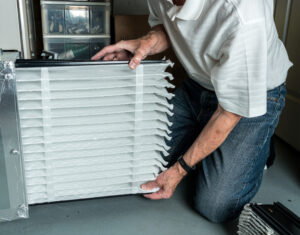MERV 8 vs Merv 11 vs Merv 13: Which is Best?

*Updated December 11th, 2025
As a homeowner, you know your HVAC system needs an air filter, but did you know there are different MERV ratings that affect how well your filter captures airborne particles? The difference between MERV 8 and higher MERV options directly impacts indoor air quality and can influence how you and your household feel.
A good air filter is the first line of defense against indoor air contaminants, but choosing the wrong furnace filter may put unnecessary strain on your HVAC system. When your HVAC air filter restricts airflow too much or isn’t strong enough to filter the air effectively, it can lead to reduced comfort and decreased system performance.
According to the American Lung Association, indoor air can be up to 100 times more polluted than outdoor air. This can cause issues for anyone, especially those with allergies, asthma, or other respiratory concerns.
However, by choosing the right filter for your home, you can significantly improve indoor air quality and reduce exposure to fine particles. The better the filter is at capturing particles from the air, the cleaner your home’s air will be.
Understanding MERV 8 vs MERV 11 vs MERV 13 air filters and how their filtration levels affect both your family and your HVAC system is essential for choosing the best MERV rating.
What is a MERV rating?
MERV stands for Minimum Efficiency Reporting Value. The MERV rating chart indicates how effectively a filter captures airborne particles, such as dust, pollen, mold spores, pet dander, smoke, and bacteria. This scale ranges from 1 to 16, and the higher the MERV rating, the smaller the particles the filter is capable of capturing.
MERV ratings are based on a filter’s ability to capture microns between 0.3 and 10 microns. Smaller microns require a higher MERV filter. For example, MERV 13 air filters capture much smaller particles than a basic fiberglass filter or a standard MERV 8 filter.
Basic air filters can capture larger particles, but homes with sensitive individuals may require higher MERV filtration to improve your indoor air quality.
Most households use a MERV 8 filter, but homes with allergies, pets, or chronic health issues may benefit from MERV 11 or MERV 13 air filters.
Overview of MERV 8 Filters
MERV 8 filters are among the most commonly used air filters because they provide balanced filtration without restricting airflow too much.
Definitions and Characteristics
According to the EPA, a MERV 8 filter captures up to 70% of particles measuring 3.0–10 microns and around 20% of particles between 1.0–3.0 microns. This filtration level is suitable for standard homes without major indoor air quality concerns.
However, because a MERV 8 filter captures few particles smaller than 1 micron, pollutants like pet dander and airborne bacteria may pass through.
Advantages
- Captures most common household pollutants (dust, pollen, lint)
- Filters provide adequate protection for most HVAC systems
- Affordable and widely available
Limitations
- May not improve indoor air quality enough for allergy sufferers
- Allows smaller particles—including some bacteria—to pass through
Overview of MERV 11 Filters
MERV 11 filters are a step up from MERV 8 filters, offering better filtration for homeowners who want cleaner air without jumping to the highest MERV rating.
Definitions and Characteristics
MERV 11 filters capture:
- Up to 85% of 3.0–10 micron particles
- Up to 65% of 1.0–3.0 micron particles
- About 20% of 0.3–1.0 micron particles
This level of filtration captures more pet dander, smaller dust particles, and some bacteria—making MERV 11 filters a strong option for pet owners.
Advantages
- Helps reduce allergy and asthma symptoms
- Captures finer particles like pet dander
- Offers better air filtration without jumping to HEPA filters
Limitations
- Higher MERV rating restricts airflow more than MERV 8
- Not suitable for all HVAC systems—can strain older units
Overview of MERV 13 Filters
MERV 13 filters are the maximum rating most residential HVAC systems can handle safely. These filters are designed for improved air purification and higher air quality needs.
Definitions and Characteristics
A MERV 13 filter captures:
- 90% of 3.0–10 micron particles
- 85% of 1.0–3.0 micron particles
- About 50% of 0.3–1.0 micron particles
MERV 13 air filters capture many airborne viruses, fine particulate matter, and smoke particles.
Advantages
- Provides cleaner air for sensitive or at-risk individuals
- Captures microscopic allergens and pollutants
- Recommended in homes with smokers, newborns, or severe allergies
Limitations
- Can cause airflow restriction if your HVAC system isn’t designed for it
- More expensive than MERV 8 or MERV 11 filters
Comparison Between MERV 8, 11, and 13 Filters
When comparing MERV 8 vs MERV 11 vs MERV 13, the higher the MERV rating, the more particles the filter captures. MERV 8 filters provide basic filtration, MERV 11 filters capture finer particles, and MERV 13 air filters offer the highest residential air cleaner performance.
However:
- Higher MERV ratings increase airflow resistance
- A higher MERV filter may strain your HVAC system
- Filter replacement frequency increases with higher filtration levels
Always follow manufacturer guidelines before upgrading to a higher MERV filter.
How Often Should You Change Your Air Filter?
Proper filter maintenance is essential for maintaining airflow and indoor air quality.
General filter replacement guidelines:
- MERV 8 filter: Every 60–90 days (30–60 with pets)
- MERV 11 filter: Every 30–60 days
- MERV 13 filter: Every 30–45 days
Clogged filters restrict airflow, forcing the HVAC system to work harder.
Signs You May Need a Higher MERV Rating
You may benefit from a higher MERV filter if you notice:
- Increasing allergies or asthma symptoms
- Excessive dust in your home
- Musty or stale indoor air
- Pets producing dander
- Construction or pollution near your home
Upgrading from MERV 8 to MERV 11 or MERV 13 can help improve your indoor air quality.
Factors to Consider When Choosing Between MERV Ratings
Specific air quality concerns
Households with allergies, asthma, or respiratory conditions may benefit from a MERV 11 or MERV 13 filter.
HVAC system compatibility
Not all HVAC systems can handle a high MERV rating. Use MERV filters only within manufacturer recommendations.
Budget considerations
Higher MERV filters cost more but offer better air filtration.
Conclusion
Choosing the right air filter and MERV rating requires balancing cleaner air with proper HVAC system performance. While MERV 8 filters provide basic filtration, MERV 11 offers better air quality, and MERV 13 filters capture the smallest particles, but may strain systems not designed for high MERV use.
Before switching from MERV 8 to MERV 11 or MERV 13, check your system specifications and replace filters regularly to maintain airflow and indoor air quality.
Check Out Additional HVAC Resources
- Guide to HVAC Hard Start Kits
- Guide to Furnace Installation
- Ductless Mini Splits vs Central AC
- What is Auxiliary Heat?
- How to Clean a Clogged AC Drain Line
Sources

Anna has over six years of experience in the home services and journalism industries and serves as the Content Manager at MyHomePros.com, specializing in making complex home improvement topics like HVAC, roofing, and plumbing accessible to all. With a bachelor’s degree in journalism from Auburn University, she excels in crafting localized, comprehensive guides that cater to homeowners’ unique needs. Living on both coasts of the United States has equipped her with a distinctive perspective, fueling her passion for turning any house into a cherished home through informed, personalized decision-making.
Connect with top-rated local contractors who can help you with siding, roofing, HVAC, windows, and more. Get free quotes from verified professionals in your area today.








